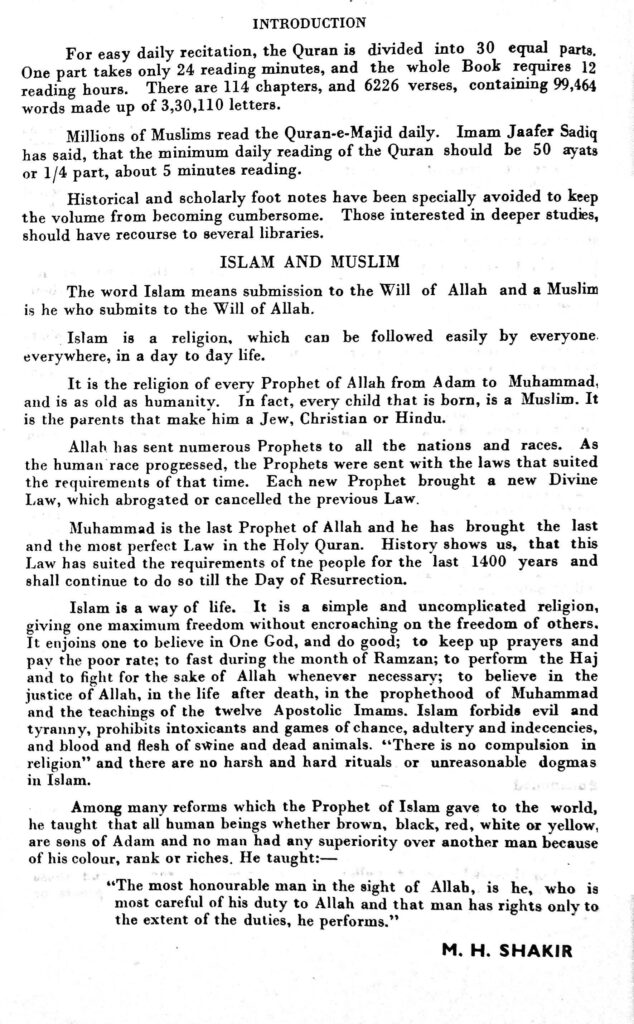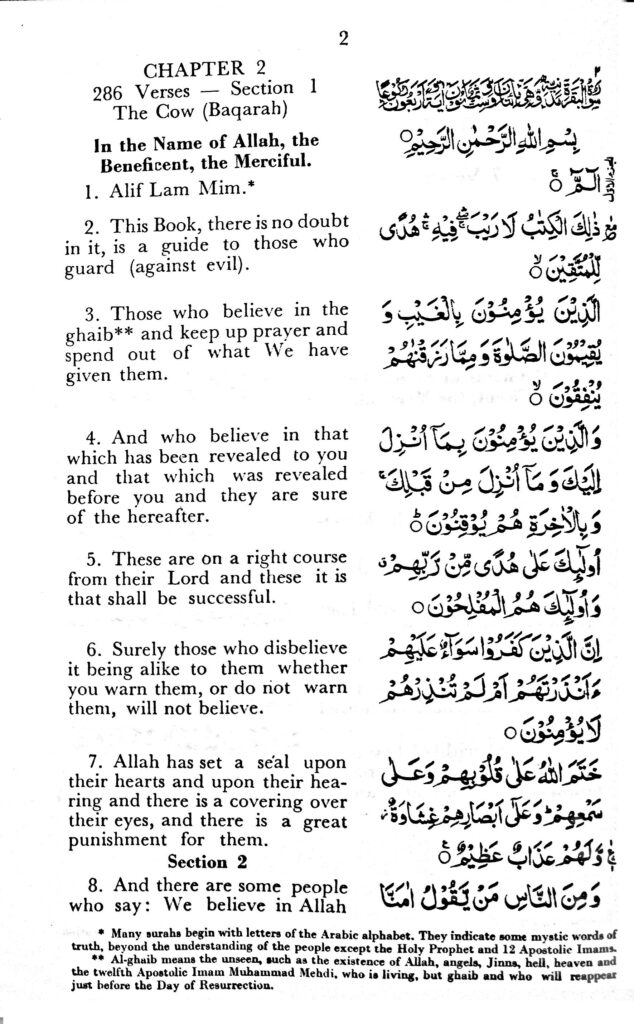The English Qur’an translation by M. H. Shakir is widely available today in various printed editions produced by numerous publishers, and also on websites and smartphone apps. It is sometimes mistakenly ascribed to the renowned Egyptian scholar Muḥammad Shākir (1866–1939), however he was an opponent of Qur’an translations and it is safe to assume that he did not know English. Moreover, the fact that the earliest editions of The Holy Quran display clear Twelver Shi’i leanings and the Arabic text of the Qur’an included in it was written in a South Asian style points to its actual place of origin as being in the Indian subcontinent. A look at the sequence of editions of M. H. Shakir’s translation brings to light not just a story of plagiarism, but also of repeated attempts to erase certain sectarian doctrines and replace them with others, that dates from the original adoption of an Ahmadiyya template by a Twelver Shi’i author in the first edition and continues with the unacknowledged changes made in more recent Sunni editions.

The first edition of this translation was published by the Habib Bank in Karachi, Pakistan, in 1968. It was either authored or commissioned by the bank’s founder, Mohammedali Habib, a rich and influential Muslim figure in pre-partition India and later in Pakistan, who had passed away in 1959: nine years after his death, his family ensured the publication of the work. Apparently, Habib used ‘Shakir’ as a pen name. He did not speak Arabic and therefore did not produce his translation from the Arabic Qur’an. Rather, he used as his template the widely available English Qur’an translation by Muhammad Ali, first published in Woking, Surrey, in 1917 (see https://gloqur.de/quran-translation-of-the-week-106-the-first-influential-muslim-authored-translation-of-the-quran-into-english/). Muhammad Ali was the head of the Lahore Ahmadiyya, one of two branches of the Ahmadiyya movement, both of which were very actively involved in producing and distributing English-language Islamic literature at the time, an activity to which Habib himself seems to have contributed financially at some point. When producing his Qur’an translation, Habib/Shakir – or, according to one source, a team commissioned by him – essentially produced a superficially revised version of Muhammad Ali’s translation. (For more information on the Lahore Ahmadiyya’s claim of plagiarism, which seems justified, see https://ahmadiyya.org/movement/shakir.htm and https://www.ahmadiyya.org/movement/shakir-2.htm.) The revisions to Muhammad Ali’s original text largely focused on three goals: First, to rid the text of ostensibly Ahmadi elements; second, to add a Twelver Shi’i perspective to the text; and third, to replace the English names of biblical figures with Arabic ones (e.g., ‘Musa’ rather than ‘Moses’), which was sometimes done somewhat inexpertly (e.g., Muhammad Ali’s ‘Quraish’ was replaced with ‘Qureaish’). Muhammad Ali’s copious notes, section titles, and his summaries of sections and suras were removed. Beyond these aspects, there are few revisions to the text of his translation even though it is not mentioned by Shakir at all.


The ‘de-Ahmadification’ of the text is clearly visible although it was inconsistently implemented. Since Muhammad Ali took care to present his translation in a nonsectarian manner, without any mention of the Ahmadiyya’s belief in the messianic claims of Mirza Ghulam Ahmad, the next most obvious Ahmadiyya identity marker targeted by Shakir concerns their belief that Jesus died as a mortal man while still on earth (in Kashmir, where he was buried), whereas most non-Ahmadiyya Muslims believe that Jesus was raised to heaven while still alive. Muhammad Ali translated God’s words to Jesus in Q 3:55 as ‘O Jesus! I will cause you to die (Ar. mutawaffīka) and exalt you in My presence …’ Shakir changed this to ‘O Isa I am going to terminate the period of your stay (on earth) and cause you to ascend unto Me …’
Shakir also removed Muhammad Ali’s esoteric interpretation of the disjointed letters. For example, Muhammad Ali translated the letters alif lām mīm that preface Q 2:1 as ‘I am Allah, the best Knower,’ whereas Shakir’s edition rendered the verse as ‘Alif Lam Mim’ with a footnote that clearly points to the Twelver Shi’i doctrine of the infallibility of the imams: ‘Many surahs begin with letters of the Arabic alphabet. They indicate some mystic words of truth, beyond the understanding of the people except the Holy Prophet and 12 Apostolic Imams.’

Another idiosyncratic element of Muhammad Ali’s translation, which was rooted in the Ahmadiyya’s particular brand of modernism, was his attempt to interpret miracle stories in the Qur’an in a rationalist manner. For example, according to nearly all translators, Q 2:56–57 describe God as reviving the Israelites from death (mawt), but according to Muhammad Ali, God merely roused them from a stupor. Similarly, and contrary to the general exegetical opinion, he did not believe that contact with Joseph’s shirt gave Jacob back his eyesight (yaʾti baṣīran), but rather that it gave him knowledge and certainty (Q 12:93 and 96).
Shakir changed all these translations to reflect a more mainstream exegetical understanding in place of Muhammad Ali’s miracle-averse rationalism. However, there are instances where he (or his team) failed to implement revisions, probably because they did not recognize these particular passages as reflecting a specifically Ahmadi interpretation. This is even true of the famous case of Q 27:17–28 which tells the story of Solomon’s campaign against the queen of Sheba. The passage has Solomon understand the speech of ants (naml) and talk to a hoopoe (hudhud), who acts as his messenger. Muhammad Ali translated the term namla (‘an ant’) as ‘a Namlite’ and explained this as referring to the (human) member of a tribe called ‘Namlites.’ Moreover, he treated the word hudhud (‘hoopoe’) as a proper name, denoting a (human) messenger. With this strategy, he removed the supernatural element from the story. Shakir copied Muhammad Ali’s translation of this segment completely, up to and including the sura title: ‘The Naml,’ rather than ‘The Ants.’
Shakir’s translation started to have an international impact when it was reprinted in Tehran in 1974 by the ‘World Organization for Islamic Services’ (see https://quran-archive.org/explorer/m-h-shakir/1974).


They, like many subsequent Shi’i publishers – especially Tahrike Tarsile Qur’an in the United States – were presumably attracted to it because of its strong endorsement of Twelver Shi’i doctrines. This is largely found in the footnotes but also affects the text of the translation itself. For example, Muhammad Ali translated the phrase alladhīna yuʾminūna bi’l-ghayb in Q 2:3 as ‘those who believe in the unseen’ whereas Shakir rendered the phrase as ‘those who believe in the ghaib.’ The footnote on the verse clarifies this choice: ‘Al-ghaib means the unseen, such as the existence of Allah, angels, Jinns, hell, heaven and the twelfth Apostolic Imam Muhammad Mehdi, who is living, but ghaib and who will reappear just before the Day of Resurrection.’ The use of the Arabic term ghayb (or ghaib) is thus an allusion to the Twelver Shi’i doctrine of the ghayba, or ‘absence,’ of the Twelfth Imam.


Another example is Q 2:31, wa-ʿallama Ādama l-asmāʾa kullahā, which Muhammad Ali translated as ‘And He [God] gave Adam knowledge of all the things.’ In a footnote, he referred to the thirteenth-century theologian and exegete Fakhr al-Dīn al-Rāzī as saying that al-asmāʾ (lit. ‘the names’) includes the attributes and description of things, ‘for the attributes of a thing are indicative of its nature.’ Shakir, conversely, translated the segment literally as ‘And He taught Adam all the names’ and added a footnote that says, ‘The names are Muhammed, Ali, Fatemah, Hasan and Husein.’ This understanding of ‘names’ as being limited to a set of five proper names of persons belonging to the Prophet Muḥammad’s family is far narrower than that of the exegetical mainstream, including among Twelver Shi’i exegetes such as al-Ṭabarsī and even al-Qummī, who held that Adam was taught the names of animals, plants, physical objects, geographical features and so forth. It is this apologetic intent that makes the translation stand out.
More recent Sunni editions – while not entirely identical to one other – largely have in common that they have both de-Shi’ified and further de-Ahmadified the translation. They usually do not contain any notes at all, thereby removing most of the Shi’i references. They have also replaced the term ‘ghaib’ in the translation of Q 2:3 with ‘unseen,’ thereby returning to Muhammad Ali’s original translation and removing the allusion to the ghayba of the Twelfth Imam. In addition, many of the editions have changed the title of Q 27 from ‘The Naml’ to ‘The Ant’ or ‘The Ants,’ or at least added a reference to ants in brackets. But, at the same time, they have overlooked the use of ‘Naml’ and ‘Namlite’ in the translation of Q 27:18, which produces the rather strange effect that in these editions the sura is named after ants but no actual ants appear in the English translation of the text of the sura. The de-Shi’ification is just as inconsistent; for example, Shakir’s Shi’i version of Q 5:6, a verse that describes the ritual ablution before prayer, is usually retained, probably because it had no footnote that pointed to an ostensibly Shi’i doctrine and would have flagged the verse up for revision.
In a few cases, comparing Muhammad Ali and the various Shakir editions allows us to identify a sequence of changes. For example, in their respective translations of Q 105, the first three verses remain unchanged, but when it comes to verse 4, the editions incrementally move away from Muhammad Ali’s idiosyncratic and grammatically problematic translation towards a more conventional understanding of the verse.
| Muhammad Ali 1917 | Shakir, Tehran 1974 | Shakir, three recent online editions |
| Q 105:1 Have you not considered how your Lord dealt with the possessors of the elephant? 2 Did He not cause their war to end in confusion, 3 And send down (to prey) upon them birds in flocks, | Q 105:1 Have you not considered how your Lord dealt with the possessors of the elephant? 2 Did He not cause their war to end in confusion, 3 And send down (to prey) upon them birds in flocks, | Q 105:1 Have you not considered how your Lord dealt with the possessors of the elephant? 2 Did He not cause their war to end in confusion, 3 And send down (to prey) upon them birds in flocks, |
| 4 Casting them against hard stones… | 4 Casting them against stones of baked clay… | 4 Casting against them stones of baked clay… |
Interestingly, all versions contained the insertion ‘to prey’ in brackets, pointing to Muhammad Ali’s unique theory that the birds described in the sura were birds of prey who, far from killing the ‘possessors of the elephant,’ preyed on their dead bodies after they had perished of smallpox. Shakir and, it seems, most of the subsequent editors were not sufficiently well-versed in Qur’anic exegesis to reliably recognize translations that were specific to Muhammad Ali and/or the Ahmadiyya.
The strategy at work in Shakir’s translation is not at all uncommon, namely, using Muhammad Ali’s Ahmadiyya rendition as the basis for a new translation while refusing to acknowledge the influence – or even the existence – of his translation and trying to erase all ostensibly Ahmadi elements from it. What makes it unique is that the initial attempt to Shi’ify an originally Ahmadi text is followed by subsequent attempts on the part of Sunni editors to remove the Shi’i elements, turning this oft-reprinted and widely distributed text into a fascinating document of sectarian tensions in Qur’an translation.
Johanna Pink